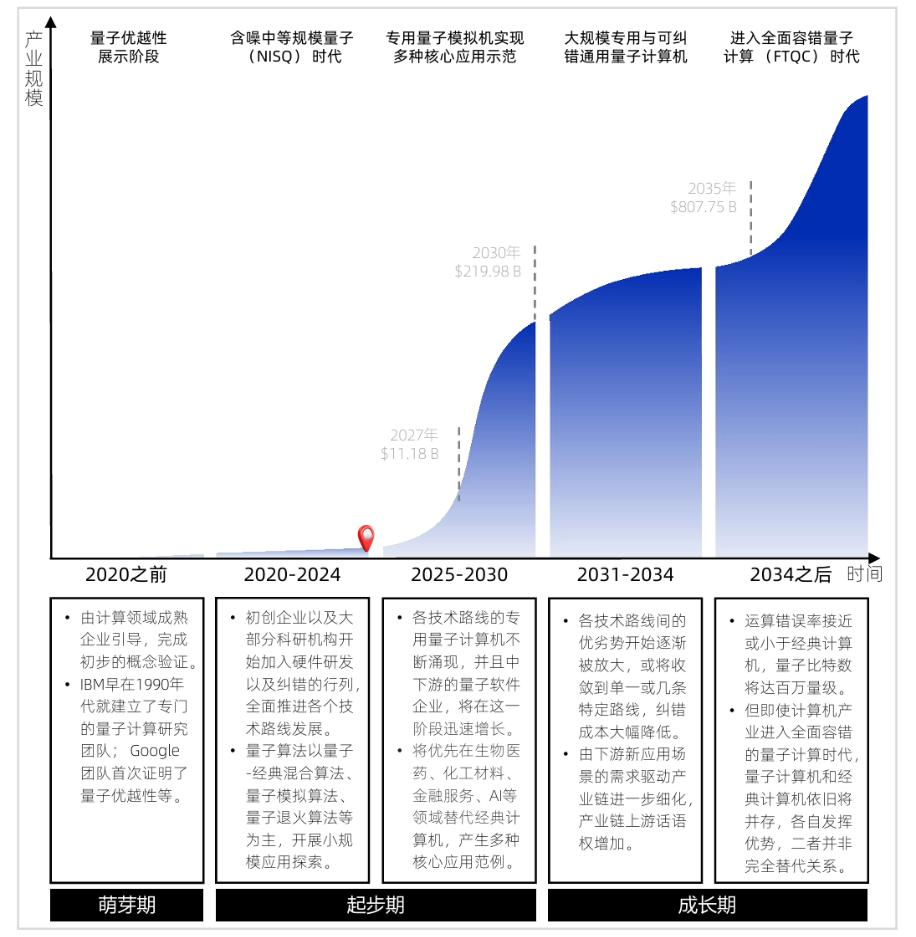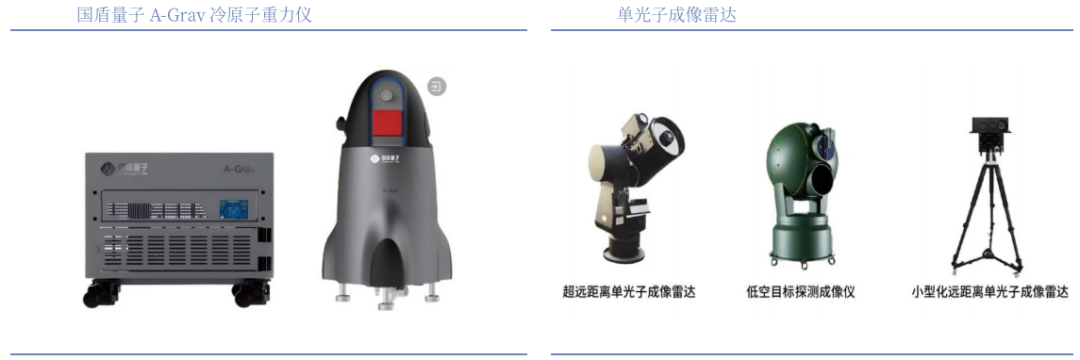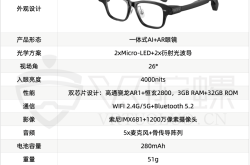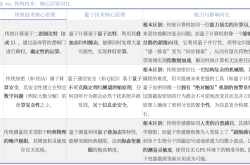Quantum Technology: Catalyzing Industrial Transformation and Unleashing a New Economic Growth Engine
![]() 11/28 2025
11/28 2025
![]() 559
559
Quantum technology represents a state-of-the-art technological cluster rooted in the fundamental tenets of quantum mechanics. It harnesses the active regulation and exploitation of quantum states (including superposition and entanglement) in microscopic particles. This field stands as a strategic vantage point in the global technological race and a pivotal force propelling future industrial upgrades and economic-social transformations.
Diverging from traditional technologies that predominantly hinge on classical physical laws, quantum technology achieves theoretical leaps in information processing, transmission, and measurement through precise manipulation of quantum states. Its core industrial applications predominantly span three key domains: quantum computing, quantum communication security, and quantum precision measurement.
Among these, quantum computing boasts computational prowess far surpassing that of traditional computers, enabling revolutionary breakthroughs in areas such as novel drug discovery, material design, and financial modeling. Quantum communication, grounded in the no-cloning principle of quantum mechanics, ensures theoretically absolute security for information transmission, serving as a critical bulwark for future digital economies and national information security. Quantum precision measurement, capable of surpassing classical measurement thresholds, finds extensive applications in high-precision fields like navigation, energy, and healthcare.

Since the '14th Five-Year Plan' first identified quantum information as one of the seven frontier areas of science and technology, initiatives such as 'quantum secure communication,' 'quantum computing,' and 'quantum precision measurement' have been progressively integrated into development blueprints and key projects across various regions nationwide. The '15th Five-Year Plan' proposals once again underscored the significance of quantum technology, proposing forward-looking strategies for future industries and promoting quantum technology, biomanufacturing, hydrogen energy and nuclear fusion, brain-computer interfaces, embodied intelligence, 6G, and other sectors as new engines of economic growth.
Quantum Computing and Its Industrial Chain
Quantum computing is a computational paradigm that leverages the principles of quantum mechanics for information processing. Its essence lies in employing quantum bits (qubits) as fundamental computational units, achieving radical transformations in information processing through properties such as superposition, entanglement, and interference.
Compared to traditional computers, quantum computing harbors exponential acceleration potential for specific complex problems (e.g., large number factorization, molecular simulations). Through tailored algorithms, quantum computing can demonstrate faster, more precise, and resource-efficient computational advantages over classical computers, poised to become a pivotal driver of future computational power leaps.
The current global competitive landscape in quantum computing is intensifying, with technology blockades extending from complete systems to upstream core equipment and components. Against this backdrop, China is accelerating the self-reliance of its industrial chain, achieving notable progress in core equipment research and system integration, gradually constructing an independent industrial ecosystem.
According to research analysis, in terms of the capability rankings of complete quantum computer systems, the United States and China occupy the first tier, while Europe and the Asia-Pacific region (excluding China) form the second tier.

The upstream segment of the quantum computing industrial chain lays the foundation for constructing quantum computing systems. Its core value lies in providing the necessary physical carriers and environmental support for the stable existence and precise manipulation of qubits.
Currently, the upstream chain primarily encompasses ultra-low-temperature environments, precision measurement and control systems, and core photonic/chip components. Their maturity directly constrains the performance and scalability of midstream and downstream complete systems. Comparatively, European and American countries boast a larger number of enterprises in the upstream ecosystem of the quantum computing industry with higher development levels, amassing superior conditions and resources in product development, technological innovation, and market demand. While Chinese upstream enterprises have witnessed rapid development in recent years, launching various self-developed products, there remains significant room for improvement in performance indicators, manufacturing costs, and market recognition of some key equipment components. Domestic substitution remains the primary objective for Chinese manufacturers.
Midstream enterprises in the industrial chain, including quantum computing prototype manufacturers and software suppliers, constitute the core link of the quantum computing industrial ecosystem and also a segment with a relatively concentrated number of enterprises. Regarding prototypes, among global enterprises engaged in quantum computing prototype development, those focusing on superconducting routes account for the largest proportion, exceeding one-third of the total, followed by technical routes such as ion traps, neutral atoms, photonic quantum, and silicon semiconductors.
The core value of the downstream industry lies in democratizing access to quantum computational power and transforming it into industrial applications. Currently, quantum cloud services serve as the core conduit in the downstream chain, effectively addressing the core challenges of high acquisition costs and complex operation and maintenance of quantum computers.
Through national policy guidance and systematic layout, a series of breakthroughs have been achieved in the upstream sector for key equipment, with core components such as dilution refrigerators and measurement and control systems gradually completing domestic substitution. In the midstream, an innovation system centered around universities, research institutes, and affiliated enterprises continues to exert effort, albeit facing challenges such as relatively constrained R&D funding. State-owned enterprises like China Telecom Quantum Group are actively assuming a leading role in the industry, collaborating with innovative forces to jointly drive technological development.

Quantum Information Security and Its Industrial Chain
Quantum security represents a relatively mature and highly predictable market within the quantum technology sector. As the core defensive system against quantum computing threats, quantum security has forged a technological architecture with physical-layer security and mathematical-layer security as its dual pillars: The physical route, namely quantum secure communication, centers on the security of key distribution. It exploits physical properties such as the indivisibility, non-replicability, and uncertainty of quantum mechanics to generate true random numbers as encryption keys and ensures that any eavesdropping behavior will be detected by the communicating parties due to interference with quantum states, thereby guaranteeing the process security of key transmission based on physical principles.
Complementarily, the mathematical route focuses on post-quantum cryptography (PQC), aiming to design and deploy new cryptographic algorithms that ensure long-term information security even under attacks from future quantum computers, maintaining sufficient computational complexity.
PQC (Post-Quantum Cryptography) and QKD (Quantum Key Distribution) represent two mainstream technological routes for achieving quantum security, yet they are not mutually exclusive. Given China's well-established fiber optic infrastructure, QKD can seamlessly integrate with it, forming a long-term and reliable foundation for information security. Meanwhile, introducing PQC capitalizes on its advantages of algorithmic flexibility and ease of upgrades, providing effective enhanced protection.
Therefore, QuantumCTek advocates for adopting an integrated protection model of 'QKD as the foundation and PQC as enhancement' based on China's national conditions.

The upstream segment of the quantum security industrial chain serves as the technological bedrock, focusing on R&D breakthroughs in core hardware and basic software. At the hardware level, specialized optoelectronic devices such as quantum light sources and single-photon detectors, along with high-performance cryptographic computing chips, form the foundational support for industrial development. At the software level, core technological barriers are constructed around key links such as the design of post-quantum cryptographic algorithms and the implementation of quantum communication protocols.
The midstream segment undertakes the role of technological productization and solution integration. Manufacturers transform upstream core technologies into commercial devices such as quantum key distribution terminals and quantum random number generators. By constructing hybrid security solutions that integrate quantum key distribution and post-quantum cryptography, they promote the synergistic development of 'physical security' and 'mathematical security.'
The downstream segment has achieved certain application results in high-security-demand fields such as finance, government affairs, and telecommunications. Although the current market is still dominated by national-level projects, with increasing technological maturity, quantum security technologies are gradually expanding into emerging fields such as the Internet of Things, autonomous driving, and drones, providing high-security quantum safeguards.

Quantum Precision Measurement and Its Industrial Chain
Quantum precision measurement technology achieves ultra-high-precision perception of physical quantities by manipulating and reading the evolutionary information of quantum states such as atomic energy levels and particle spins. Its essence lies in 'enabling the measurement of previously unmeasurable quantities and achieving greater accuracy in measurable quantities.'
This technological system is primarily divided into directions such as trapped atoms/ions, solid-state spins, and superconducting sensing based on implementation paths. It can cover the measurement needs of key physical quantities such as magnetic fields, time-frequency, gravity, and rotation. Its core competitive advantages lie in breaking through classical measurement limits in terms of accuracy and exhibiting excellent anti-interference capabilities, enabling transformative application potential in fields such as national defense reconnaissance, resource exploration, medical imaging, and next-generation communication systems.
Typical application scenarios include QuantumCTek's cold atom gravimeter, which can measure Earth's gravitational acceleration with an accuracy of up to eight decimal places and perform continuous networked measurements to detect subtle underground geological changes. Another example is photonic quantum radar, which can detect impurities such as aerosols in the air, addressing limitations of traditional radar, including eye safety hazards, slow data updates, visible beams prone to exposure, performance variations between day and night, and inability to operate in densely populated areas.

The upstream segment of the quantum precision measurement industry primarily encompasses core hardware, peripheral support systems, and auxiliary hardware: In the core hardware domain, superconducting nanowire single-photon detectors serve as critical components for applications like quantum radar due to their exceptional detection performance; ultra-stable narrow-linewidth lasers provide precision guarantees for devices such as optical clocks. Peripheral support systems create ideal environments for quantum state manipulation through the synergy of cryogenic, vacuum, magnetic shielding, and vibration isolation technologies. Additionally, among auxiliary hardware, components such as high-performance cryogenic cables and electro-optic modulators undertake crucial functions in signal fidelity preservation and precise conversion.
In the midstream complete machine manufacturing domain, quantum sensors are rapidly evolving toward integration and modularization. Currently, technologies in time-frequency, magnetic field, and gravity sensing have achieved relatively high maturity, enabling application breakthroughs across multiple industries. However, technological advantages in electric field and temperature sensing directions remain to be fully unleashed. Future complete machine development will focus on miniaturization and low-power design to expand application scenarios in industrial inspection, mobile devices, and other broader fields, potentially driving the transformation of quantum precision measurement from specialized instruments to universally accessible tools and laying a solid foundation for the prosperity of downstream application ecosystems.
Quantum precision measurement technologies find extensive applications in downstream fields: In the time-frequency metrology domain, atomic clocks provide high-precision time references for critical infrastructures such as satellite navigation, financial settlements, and deep-space exploration with their exceptional frequency stability. Quantum imaging and radar technologies establish new technological paradigms in fields like national defense reconnaissance, intelligent transportation, and environmental monitoring by breaking through classical detection limits. In the biomedical field, quantum magnetometers offer new tools for brain science research and neurological disease diagnosis and treatment with their ultra-high spatiotemporal resolution.

The quantum technology sector is making a significant shift, moving from the realm of laboratory research and development (R&D) into the domain of industrial applications. At present, investment efforts ought to be directed towards the upstream segments focused on core components and the midstream areas dedicated to system integration. These segments are characterized by high technological barriers and well - defined paths to commercialization. By doing so, investors can secure strategic positions within key core companies and along vital industrial chains.
Disclaimer: The individual stocks or companies referenced in this article are solely linked to the relevant industrial chain or hot - button topics. The information, data, and viewpoints presented here are recorded for the purpose of personal research. Any mention of individual stocks or companies is intended solely for case - study discussions and should not be construed as investment advice.
QuantumCTek (688027)
QuantumCTek's quantum communication product lineup is diverse. It mainly encompasses core equipment for quantum secure communication networks, essential core components, quantum security application products, as well as management and control systems for quantum secure communication networks. Beyond these products, the company also offers a range of services. These include technology development and verification services based on quantum communication, operation and maintenance services for quantum secure communication networks, and various technical services related to quantum security applications.
In the realm of quantum computing, QuantumCTek's offerings are equally impressive. The company's main quantum computing products consist of complete superconducting quantum computer systems. Additionally, it provides core components such as measurement and control systems and dilution refrigerators. Alongside these products, the company also extends quantum computing - related technical services to its clients.
When it comes to quantum precision measurement, QuantumCTek has a comprehensive range of products. Its main quantum precision measurement products include equipment and components like cold atom gravimeters, single - photon imaging radars, single - photon detectors, and optical sensors. Moreover, the company offers relevant technical services in the field of quantum precision measurement.

Hexin Instruments (688622)
Hexin Instruments is actively expanding its business horizons. The company has formulated a plan to acquire a 56% stake in Shanghai Liangxi Technology Co., Ltd. This acquisition will be carried out through a combination of share issuance and cash payment. Shanghai Liangxi is a key player in the quantum computing industry's upstream segment. It primarily supplies ultra - low - temperature and extremely weak signal measurement and control equipment for quantum computers, acting as a provider of supporting equipment systems, including dilution refrigerators and cryogenic devices.
The acquisition of Shanghai Liangxi is expected to bring multiple benefits to Hexin Instruments. It will enable the company to establish a foothold in the dilution refrigerator industry, which is known for its high technological barriers. Furthermore, it will accelerate the localization and commercialization process of core equipment for superconducting quantum computing. By entering this cutting - edge sector of quantum technology, Hexin Instruments is anticipated to witness an overall improvement in the operating performance of the listed company.









